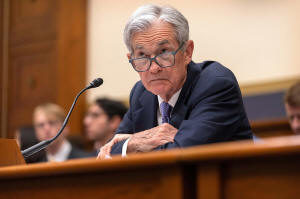Powell says Fed rate cut is on hold even as Trump demands cuts
[June 25, 2025] By
CHRIS RUGABER
WASHINGTON (AP) — The Federal Reserve will continue to wait and see how
the economy evolves before deciding whether to reduce its key interest
rate, Chair Jerome Powell said Tuesday, a stance directly at odds with
President Donald Trump’s calls for immediate cuts.
“For the time being, we are well positioned to wait to learn more about
the likely course of the economy before considering any adjustments to
our policy stance,” Powell said in testimony Tuesday before the House
Financial Services Committee.
Several Republicans on the committee pushed Powell to consider reducing
borrowing costs more quickly, as soon as its next meeting at the end of
July. But on the whole, the hearing was uniformly polite and Powell did
not face sharp criticism over the Fed's decision to leave its rate
unchanged.
Members of both parties thanked Powell for maintaining his focus on the
Fed's dual mission of controlling inflation and supporting maximum
employment. Powell has often cited his support in Congress as a bulwark
against Trump’s attacks.
Trump lashed out again early Tuesday, posting on his social media site:
“I hope Congress really works this very dumb, hardheaded person, over.
We will be paying for his incompetence for many years to come.”
Several Republicans asked Powell why the central bank has yet to lower
borrowing costs. Powell responded that most economists, inside and
outside the Fed, still expect tariffs to push inflation higher, and Fed
policymakers want to see what happens over the next couple of months
before making any changes.
“We do expect tariff inflation to show up more," Powell said. "We really
don’t know how much of that’s going to be passed through the consumer.
We have to wait and see.”

Under questioning, Powell acknowledged that tariffs might not push up
inflation as much as economists forecast. That, he said, could lead the
Fed to reduce rates more quickly. A sharp rise in the unemployment rate
could also spur the Fed to cut borrowing costs more quickly, he said.
“We could see inflation come in not as strong as we expect,” he said.
“And if that were the case, that would tend to suggest cutting sooner.”
But when asked specifically about July, Powell declined to comment.
Powell also said he expected to see tariffs' impact on prices emerge in
the next few months, starting in June. The June inflation report will be
released July 15.
Rep. Josh Gottheimer, a Democrat from New Jersey, asked Powell whether
Trump's “bullying” would impact the Fed's decision-making.
Powell said the Fed wants to “deliver a good economy for the benefit of
the American people, and that’s it.”
“Anything else is kind of a distraction," Powell added. "We always do
what we think is the right thing to do, and we live with the
consequences. I don’t know how else to do the job.”
The Fed’s 19-member interest rate setting committee, led by the chair,
decides whether to cut or raise borrowing costs. They typically increase
rates to cool the economy to fight or prevent inflation, and lower rates
when the economy is weak to boost borrowing and spending.
The Fed’s committee voted unanimously last week to keep its key rate
unchanged, though the Fed also released forecasts of future rate cuts
that revealed emerging divisions among the policymakers. Seven projected
no rate cuts at all this year, two just one, while 10 forecast at least
two reductions.
[to top of second column] |

Federal Reserve Board Chairman Jerome Powell listens during a
hearing of the House Committee on Financial Services on Capitol
Hill, Tuesday, June 24, 2025, in Washington. (AP Photo/Mark
Schiefelbein)
 The Fed chair said the bump to
inflation from tariffs could be temporary, or it could lead to a
more persistent bout of inflation.
The Fed's “obligation,” Powell said, “is ... to prevent a one-time
increase in the price level from becoming an ongoing inflation
problem.”
At a news conference last week, Powell suggested the Fed would
monitor how the economy evolves over the summer in response to
Trump’s tariffs, hinting that a rate cut wouldn’t occur until
September.
Yet two high-profile members of the Fed’s governing board, Michelle
Bowman and Christopher Waller, have since suggested the central bank
could cut its rate as early as July. Both officials were appointed
by Trump during his first term and Waller is often mentioned as a
potential replacement for Powell when his term ends next May. Powell
was also appointed by Trump in late 2017.
Other officials, however, are still cautious about rate reductions.
Beth Hammack, president of the Federal Reserve's Cleveland branch,
said Tuesday that given the uncertainty enveloping the economy,
rates may be on hold for "quite some time" before the Fed decides to
make “very modest cuts.”
Trump is urging the Fed to cut rates to save the U.S. government
money on interest payments affixed to the vast national debt. Yet
the Fed has long resisted consideration of the government's
financing costs when making interest rate decisions, preferring
instead to focus on the health of the economy and inflation..
Waller, in an interview Friday, said that lowering the government's
borrowing costs is “not our job” and added that it was up to
Congress and the White House to reduce the budget deficit.
Trump meanwhile, on social media Tuesday repeated his false claim
that the European Central Bank has cut its key rate ten times while
the Fed has not cut at all. In fact, in the last 12 months the ECB
has reduced its rate eight times and the Fed has done so three
times, all late last year.
The Fed's cuts last year lowered its rate to about 4.3%. Since then
it has put reductions on pause out of concern that Trump’s tariffs
lead to inflation. The president has slapped a 10% duty on all
imports, along with an additional 30% levy on goods from China, 50%
on steel and aluminum, and 25% on autos.
Yet inflation has steadily cooled this year despite widespread
concerns among economists about the impact of tariffs. The consumer
price index ticked up just 0.1% from April to May, the government
said last week, a sign that price pressures are muted.
All contents © copyright 2025 Associated Press. All rights reserved
 |